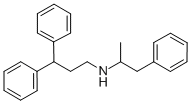Prenylamine is a calcium channel inhibitor. It inhibits the plasma membrane Ca2+ ATPase (PMCA) in isolated and purified pig cardiac sarcolemma. It binds to a hydrophobic site on calcium-bound calmodulin (CaM) with a Kd value of 0.5 μM and inhibits CaM-activated cAMP phosphodiesterase (PDE) activity when used at concentrations ranging from 10 to 50 μM, an effect that is negatively associated with the concentration of calmodulin. Prenylamine (30 μM) shortens action potential duration and decreases the amplitude of peak calcium currents in single guinea pig ventricular myocytes in the absence and presence of propranolol and phentolamine . Prenylamine (50 mg/kg) decreases epinephrine, serotonin, and dopamine levels in rat brain. It also decreases epinephrine levels in rat heart. It protects anesthetized rats from coronary artery occlusion-induced arrhythmia when administered at a dose of 0.5 mg/kg but increases mortality due to atrioventricular block leading to asystole when administered at a dose of 5 mg/kg.
World Health Organization (WHO)
Prenylamine is a calcium-channel blocking agent which was
introduced in 1960. It has been widely used for the prophylaxis of angina pectoris
and long-term treatment of coronary heart disease. Concern about its propensity to
induce dangerous cardiac dysrhythmias led the company to withdraw it from the
market.
